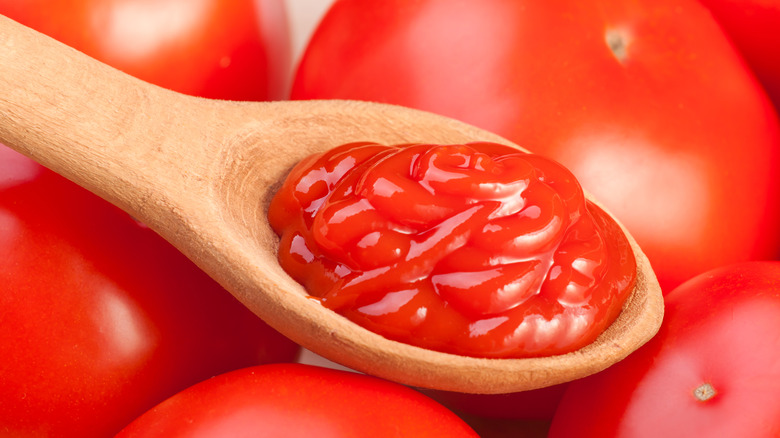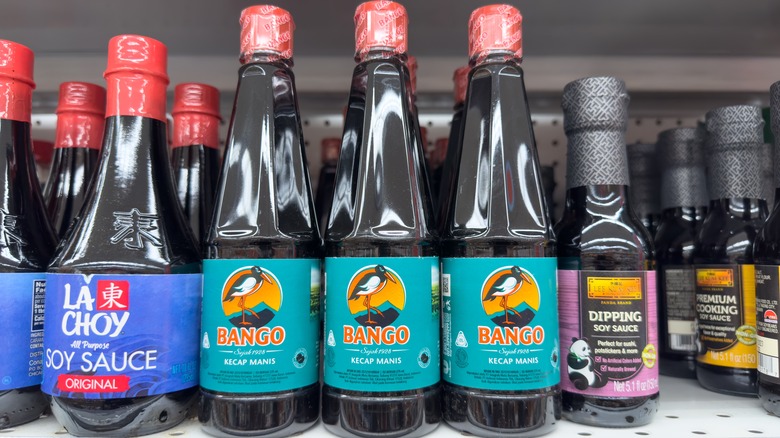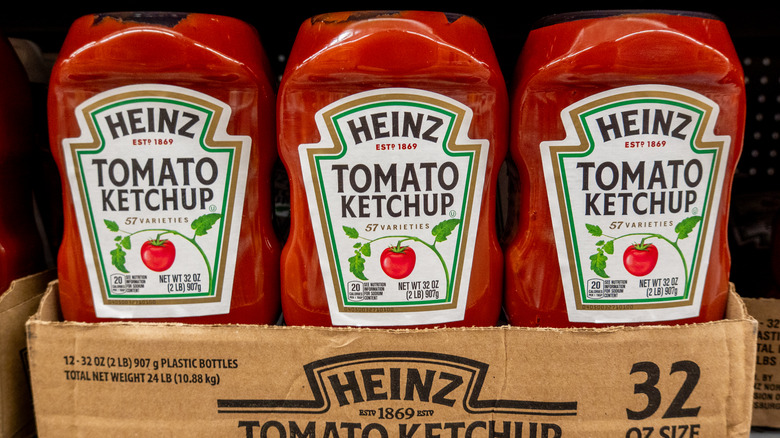The Bizarre Evolution Of Ketchup
Ketchup may seem like an all-American condiment, but you may be surprised to learn that it's not American at all — and originally, it wasn't even made with tomatoes. In fact, ketchup — or at least an earlier, tomato-free predecessor of it — hails from China, where it started out as a fermented fish sauce. Originally called kê-tsiap or kôechiap (there are various translations from the original Hokkien Chinese language), the first mention of this sauce was around 300 B.C. Likely more of a paste, it was made from a mix of fish, meat, and soybeans.
Chinese merchants then likely brought it to Indonesia, where it earned the name kecap in the local language. As time went on, the term "kecap" evolved (it arguably ended up referring to sauces in general, rather than the Chinese-born fish sauce), and eventually ended up referring to kecap manis, a thick and sweet soy sauce common in Indonesian and Malaysian cuisines to this day. Toward the late 1600s, either British or Dutch sailors or colonizers in southeast Asia discovered the fish sauce, and because it was a fermented product that would travel well without going badly, they brought it back to Europe.
Ketchup's spread around the world
By 1699, the word "catchup" had appeared in a European dictionary, where it was defined as a sauce from south or southeastern Asia. But while the name was close to "ketchup," the recipes for it would still be unrecognizable to anyone living in the 21st century. In the 18th century, there was a veritable explosion of ketchup recipes, as cooks in Britain tried to recreate the southeast Asian sauce that sailors had brought back.
It seems that the goal was to get a sauce that imitated the umami of fermented southeast Asian condiments, so fittingly, one of the earliest ketchup recipes published in English called for anchovies, vinegar, white wine, shallots, horseradish, and various spices. But plenty of other recipes emerged, centered around ingredients from oysters to mushrooms, walnuts, or plums. They were likely quite salty (not sweet) in flavor, much more liquid than present-day ketchup, and would have been used to add flavor to fish, meat, and other dishes like soup. Over the 1700s, three dominant types of ketchup ended up emerging: fish, walnut, and mushroom ketchup. By the 1800s, the names "ketchup" and "catsup" had started to be used.
America adds the tomatoes
Around the same time, colonial-era trade across the Atlantic brought these early British versions of ketchup to North America. Then, in the early 1800s, ketchup evolved again, with a scientist from Philadelphia by the name James Mease publishing a recipe for a tomato-based ketchup, made with a mix of brandy and spices. But it didn't instantly replace the other types of ketchup that existed — tomatoes weren't terribly popular in American food at the time, with some people believing them to be poisonous. Over that century, more tomato ketchup recipes surfaced, and vinegar and sugar found their way into the recipes.
In 1876, everything changed when a then-young company called Heinz (named for owner Henry J. Heinz) debuted what would become the iconic American ketchup, made with vinegar, brown sugar, tomatoes, salt, and spices. It swiftly became popular, and by the end of the 1800s, newspapers like the New York Tribune dubbed it the country's national condiment. Heinz also popularized the word "ketchup," since most other producers of similar condiments used the alternate term "catsup."
Heinz ketchup achieved market dominance (although obviously, many other brands later sprang up), and the story of how ketchup evolved from Chinese fish sauce to a bright red sweet-and-sour condiment more or less finishes there. Tweaks were later made to add more sugar and vinegar, but it's overall stayed relatively similar (and extraordinarily popular) ever since.


